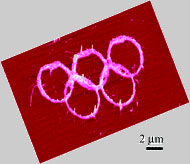| Posted: February 25, 2007 |
Rings of single-walled carbon nanotubes |
|
(Nanowerk News) The assembly and manipulation of nanoscale building blocks are among the most important scientific challenges in nanoscience because they not only afford a potential route to the fabrication of large-scale integrated nanoscale devices but also provide a better understanding of the issues that govern self-organization in many classes of materials.
|
 |
(Image: American Chemical Society)
|
|
A group of researchers at the Institute for Nanotechnology at Northwestern University have recently developed a directed assembly approach for positioning and shaping single-wall carbon nanotubes (SWNTs) into rationally designed structures based upon their interaction with nanopatterned monolayer templates.
|
|
Thir findings are reported in a paper in the January 6, 2007 online issue of Nano Letters ("Rings of Single-Walled Carbon Nanotubes: Molecular-Template Directed Assembly and Monte Carlo Modeling").
|
|
Here the SWNTs are assembled along the boundary between hydrophilic and hydrophobic molecule-based features that are deposited on a gold substrate using dip-pen nanolithography. allowing one to manipulate and assemble the SWNTs on the micrometer to sub-100-nm length scales.
|
|
Attempts to produce smaller ring structures were not successful, said the researchers.
|
|
This report concludes that the formation of SWNT rings is driven by the balance between the strain arising from tube bending and the differences in van der Waals interactions with the molecular templates. This work, together with the researchers' previous report ("Controlling the shape, orientation, and linkage of carbon nanotube features with nano affinity templates"), provides a comprehensive model for the surface assembly/manipulation of these nanoscale building blocks.
|

